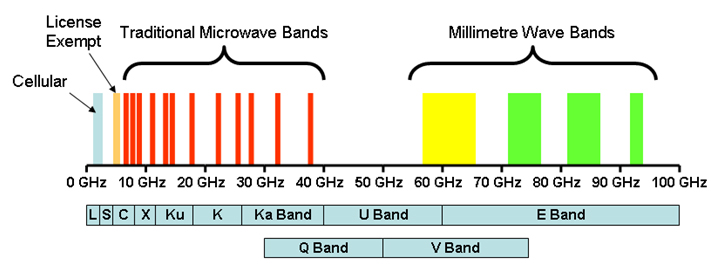It is hard to envision how the U.S. access business might change as huge amounts of new millimeter wave spectrum are made available for use. But consider that all U.S. mobile spectrum amounts to less than 800 MHz, while all Wi-Fi likewise amounts to less than 800 MHz of capacity.
Now consider that the U.S. Federal Communications Commission already is moving to add 11 GHz of new spectrum for wireless use (largely 5G). Even in raw physical terms, and ignoring the actual information-carrying capacity of the millimeter systems, the new spectrum already envisioned for deployment is more than an order of magnitude (10 times) all available mobile capacity.
When combined with advanced radio techniques, small cell architectures and the inherently-greater symbol representation of millimeter-range signals, perhaps two orders of magnitude of usable capacity (100 times) will be possible, compared to today's mobile business.
Now consider that the U.S. Federal Communications Commission already is moving to add 11 GHz of new spectrum for wireless use (largely 5G). Even in raw physical terms, and ignoring the actual information-carrying capacity of the millimeter systems, the new spectrum already envisioned for deployment is more than an order of magnitude (10 times) all available mobile capacity.
When combined with advanced radio techniques, small cell architectures and the inherently-greater symbol representation of millimeter-range signals, perhaps two orders of magnitude of usable capacity (100 times) will be possible, compared to today's mobile business.
It therefore is easy enough to predict that large swaths of existing markets could be disrupted. It is a simple matter of supply and demand, compounded by the huge amounts of unlicensed spectrum to be made available, which will change the economics of networks.
Availability of prodigious amounts of unlicensed spectrum, plus new radios, will allow at least some enterprises to build their own private networks.

Availability of prodigious amounts of unlicensed spectrum, plus new radios, will allow at least some enterprises to build their own private networks.
In principle, that could have the effect of removing some amount of the addressable public communications market, as content providers such as Google, Facebook and others now build and operate their own undersea networks, essentially removing huge amounts of demand from the public undersea capacity market.
At the same time, fixed wireless networks will emerge as direct substitutes for mass market cabled networks, for the first time, in urban markets. That should change the business case for gigabit access networks.
At the same time, for many use cases, mobile networks will emerge as full substitutes for fixed network services, for the first time.
Also, the new networks will provide a density, latency performance and bandwidth to support any number of new use cases related broadly to the internet of things, artificial intelligence and edge computing.
You can credit Moore’s Law for allowing commercial use of millimeter wave communications in the mass markets, bringing an order of magnitude (10 times) to two orders of magnitude (100 times) more usable mobile and fixed wireless spectrum to the U.S. market.
The huge trove of new capacity, dwarfing all present mobile and Wi-Fi spectrum, will reshape the economics of the access business, allowing new competitors and business models to arise, revaluing spectrum licenses, enabling fixed wireless to compete with fixed networks and positioning mobile networks as full product substitutes for fixed networks for the first time.
At its November 2017 meeting, the Federal Communications Commission will vote on an order that would make available 1,700 Megahertz of additional terrestrial wireless spectrum available for use, adding to the 11 Gigahertz of spectrum the FCC earlier had made available for flexible terrestrial wireless purposes, largely expected to support 5G use cases.
The additional 1700 Megahertz of high-band spectrum will be made available in the 24 GHz and 47 GHz bands.
As part of its Spectrum Frontiers initiative, the FCC already had started work to release new spectrum in the 28 GHz, 37 GHz, 39 GHz and 64 GHz to 71 GHz bands.
Though 3.85 GHz of that 11 GHz would be made available on a licensed basis, 7 GHz would be available to use on an unlicensed basis.
Spectrum in the 28 GHz, 37 GHz and 39 GHz bands (3.85 GHz total) represents more than four times the amount of flexible-use spectrum the FCC has licensed to date. In the 37 GHz and 39 GHz bands 200-MHz license areas would be created, with a total of 2.4 GHz available.
In the 28 GHz band, two 425 MHz spectrum blocks will be available, on a nationwide basis.
The 7 GHz of new unlicensed spectrum, combined with the existing high-band unlicensed spectrum (57-64 GHz), doubles the amount of high-band unlicensed spectrum to 14 GHz of contiguous unlicensed spectrum (57-71 GHz).
That 14 GHz band will be 15 times as much as all unlicensed Wi-Fi spectrum in the lower bands.
Also planned: shared access in the 37 GHz to 37.6 GHz band makes available 600 MHz of spectrum for dynamic shared access between different commercial users, and commercial and federal users.
No comments:
Post a Comment